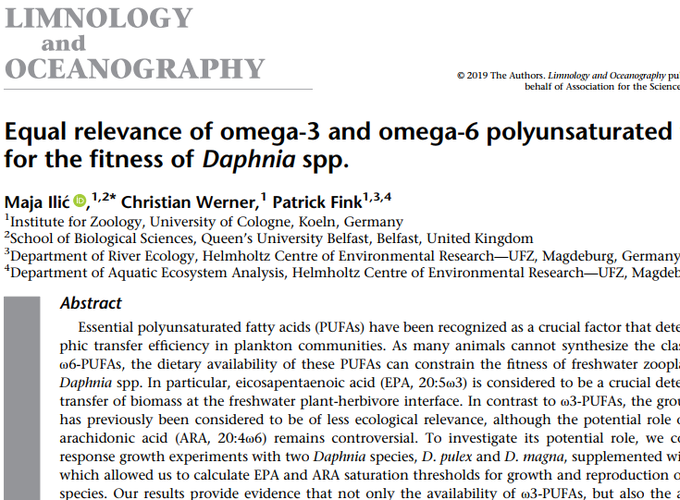Equal relevance of omega-3 and omega-6 polyunsaturated fatty acids for the fitness of Daphnia spp.
Abstract
Essential polyunsaturated fatty acids (PUFAs) have been recognized as a crucial factor that determines the trophic transfer efficiency in plankton communities. As many animals cannot synthesize the classes of ω3- and ω6-PUFAs, the dietary availability of these PUFAs can constrain the fitness of freshwater zooplankton such as Daphnia spp. In particular, eicosapentaenoic acid (EPA, 20:5ω3) is considered to be a crucial determinant of the transfer of biomass at the freshwater plant-herbivore interface. In contrast to ω3-PUFAs, the group of ω6-PUFAs has previously been considered to be of less ecological relevance, although the potential role of the ω6-PUFA arachidonic acid (ARA, 20:4ω6) remains controversial. To investigate its potential role, we conducted doseresponse growth experiments with two Daphnia species, D. pulex and D. magna, supplemented with EPA or ARA, which allowed us to calculate EPA and ARA saturation thresholds for growth and reproduction of both Daphnia species. Our results provide evidence that not only the availability of ω3-PUFAs, but also the availability of a ω6-PUFA, namely ARA, can limit both the growth and reproduction of Daphnia spp. to an equal extent. The saturation thresholds for growth and reproduction were consistently, but not significantly, higher for EPA than for ARA in both Daphnia species. As shifts in phytoplankton community composition might result in environmental fluctuations in the dietary availability of ω3- and ω6-PUFAs, our findings present a significant step in understanding the consequences of the ongoing global biodiversity loss for trophic transfer efficiency at the phytoplankton-zooplankton interface.
